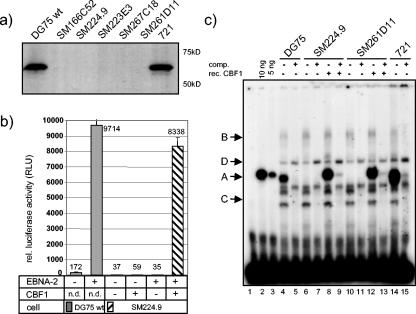FIG. 2.
SM224.9 cells are CBF1 negative and do not support EBNA-2 activation of CBF1 dependent reporter genes. (a) Whole-cell lysates prepared from the EBV positive B-cell line 721, DG75 wild-type and knockout (SM166C52, SM224.9, SM223E3, SM267C18, and SM261D11) cells were subjected to Western blot analysis by immunostaining using the CBF1-specific antibody RBP7A11-161. (b) DG75 wild-type (DG75) and knockout cells were cotransfected with a responsive CBF1 luciferase reporter plasmid (Ga981-6) and EBNA-2 (pSG5 EBNA-2) in the presence or absence of an expression vector for human CBF1 (AJ247). Results are presented as the means and standard deviations of triplicate experiments as relative light units (RLU) normalized for β-galactosidase activity. (c) Recombinant CBF1 and nuclear extracts of DG75 wild-type cells (lanes 2 and 3 and 4 and 5) were incubated with the 32P-labeled oligonucleotide from the C-promoter of EBV (Cp). Comparison with nuclear extracts from the CBF1 knockout cells SM224.9 (lanes 6 and 7) and SM261D11 (lanes 10 and 11) and after addition of recombinant CBF1 (lanes 8 and 9 and 12 and 13) reveals the position of the CBF1 complex (complex A). Nuclear extract of 721 cells was added as a control. Competition was performed with a 100-fold excess of the unlabeled Cp oligonucleotide (lanes 5, 7, 9, 11, 13, and 15). Lane 1 shows the 32P-labeled oligonucleotide alone.

